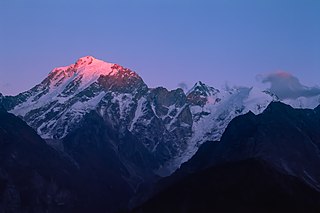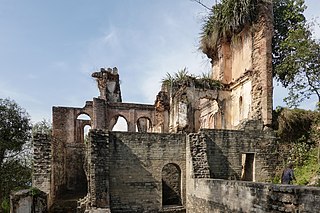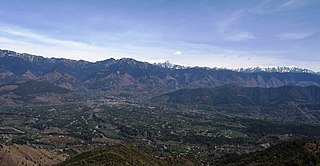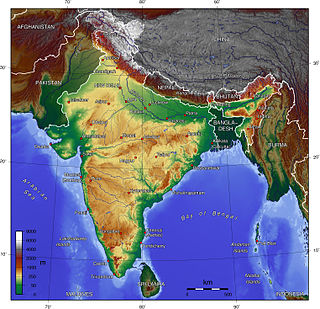
Himachal Pradesh is a state in the northern part of India. Situated in the Western Himalayas, it is one of the thirteen mountain states and is characterised by an extreme landscape featuring several peaks and extensive river systems. Himachal Pradesh is the northernmost state of India and shares borders with the union territories of Jammu and Kashmir and Ladakh to the north, and the states of Punjab to the west, Haryana to the southwest, Uttarakhand to the southeast and a very narrow border with Uttar Pradesh to the south. The state also shares an international border to the east with the Tibet Autonomous Region in China. Himachal Pradesh is also known as Dev Bhoomi, meaning 'Land of Gods' and Veer Bhoomi which means 'Land of the Brave'.

Dharamshala is a town in the Indian state of Himachal Pradesh. It serves as the winter capital of the state and the administrative headquarters of the Kangra district since 1855. The town also hosts the Tibetan Government-in-exile. Dharamshala was a municipal council until 2015, when it was upgraded to a municipal corporation.

Kangra district is the most populous district of the Indian state of Himachal Pradesh. Dharamshala is the administrative headquarters of the district.

Hamirpur district is in the Indian state of Himachal Pradesh. The headquarters of the district are in the town of Hamirpur. With an area of 1,118 square kilometres or 432 square miles, it is the smallest district of Himachal Pradesh.

Kangri is a dialect of Punjabi, spoken in northern India, predominantly in the Kangra, Una and Hamirpur of Himachal Pradesh as well as in some parts of Mandi and Chamba districts of Himachal Pradesh and Gurdaspur, Rupnagar and Hoshiarpur districts of Punjab. Kangri language is also spoken in Duggar i.e. Jammu region and in a few villages of Pakistan by the people belonging to the families migrated from Kangra Valley. It is associated with the people of the Kangra Valley. The total number of speakers has been estimated at 2.3 million as of 2024.

Kangra is a city and a municipal council in Kangra district in the Indian state of Himachal Pradesh. It is also known as Nagarkot.

The Saltoro Mountains form a subrange within the Karakoram Range and are situated in the southeastern part of the Karakoram. They lie on the southwest side of the Siachen Glacier, which is one of the two longest glaciers in the world outside the polar regions. The name "Saltoro" is also associated with the Saltoro Valley, located west of this range and descending on the Pakistani side of the Saltoro Range, which generally follows the Actual Ground Position Line (AGPL).
Nurpur is a city and a municipal council in Kangra district in the Indian state of Himachal Pradesh. It was formerly part of the Nurpur State since the 11th century AD. The capital of the state was at Pathankot formerly known as Paithan, now in Punjab. It got its name from Nur Jahan, the wife of Mughal emperor Jahangir, when they visited Kangra (Nagarkot) after Jahangir's successful conquest of the Kangra Fort.

Jogindernagar, or Jogindar Nagar, is a municipality, and a sub district in Mandi district in the Indian state of Himachal Pradesh. Named after Raja Joginder Sen, the hill station is the terminus of the 163-kilometre-long (101 mi) Kangra Valley narrow-gauge railway. Jogindernagar is the third-largest city in the Mandi district. The only city in Asia with three hydro-electric power stations, its nickname is "The City of Powerhouses".

The Tākri script is an abugida writing system of the Brahmic family of scripts. It is derived from the Sharada script formerly employed for Kashmiri. It is the sister script of Laṇḍā scripts. It has another variant Dogra Takri employed in Jammu region. There are numerous varieties present throughout Himachal Pradesh. Until the late 1940s, the adapted version of the script was the official script for writing Dogri in the princely state of Jammu and Kashmir. Throughout the history, different kingdoms of what now forms Himachal Pradesh used their own variety to maintain their records. The Takri script used in Sirmour in Himachal Pradesh and in the adjacent region of Jaunsar-Bawar in Uttarakhand has some distinction.

Kangra Valley is a river valley situated in the Western Himalayas. It lies in the state of Himachal Pradesh in India, and is a popular tourist destination. The Kangri language is spoken there. Dharamshala, the headquarters of Kangra district and the main city of the valley, lies on the southern spur of Dhauladhar.

The Indian Himalayan Region is the section of the Himalayas within the Republic of India, spanning thirteen Indian states and union territories, namely Ladakh, Jammu and Kashmir, Himachal Pradesh, Uttarakhand, Sikkim, West Bengal, Manipur, Meghalaya, Mizoram, Nagaland, Tripura, Assam, and Arunachal Pradesh. The region is responsible for providing water to a large part of the Indian subcontinent and contains various flora and fauna.

A kanger is an earthen pot woven around with wicker filled with hot embers used by Kashmiris beneath their traditional clothing pheran to keep the chill at bay, which is also regarded as a work of art. It is normally kept inside the Pheran, the Kashmiri cloak, or inside a blanket. It is mostly used in the cold nights of Chillai Kalan. If a person is wearing a jacket, it may be used as a hand warmer. It is about 6 inches (150 mm) in diameter and reaches a temperature of about 150 °F (66 °C). It comes in different variants, small ones for children and large ones for adults.

The Actual Ground Position Line (AGPL) divides current positions of Indian and Pakistani military posts and troops along the entire 110 kilometres (68 mi) long frontline in the disputed region of Siachen Glacier. AGPL generally runs along the Saltoro Mountains range, beginning from the northernmost point of the (LOC) at Point NJ 9842 and ending in the north on the Indira Ridge at the India-China-Pakistan LAC tripoint near Sia Kangri about 4 km (2.5 mi) northwest of Indira Col West, with peaks in excess of 7,000 m (23,000 ft) and temperatures ranging to around −55 °C (−67 °F). India gained control of 1,000 square miles (2,600 km2) of disputed territory in 1984 because of its military operations in Siachen. A cease-fire was announced in 2003.
Dhaam is a traditional feast celebrated in the Indian state of Himachal Pradesh, some parts of Punjab especially in Talwara and Mukerian region and Jammu region Dhaam is prepared and served on every joyful event or celebration in the family. Temples also serve dhaam on most of the religious festivals or auspicious dates.
Simbal is a 22 different types of rajput village/hamlet in Baijnath tehsil, Kangra District of Himachal Pradesh, India. It comes under Simbal Panchayath. It is located 33 km to the east of the district headquarters Dharamshala and 141 km from the State capital Shimla.
Shakoh is a village panchayat, of Lambagaon block, Jaisinghpur tehsil of the Kangra district of Himachal Pradesh, in India. It is located in the border area of the Kangra-Hamirpur district. It is the central point to Hamirpur (37Km) and Palampur. Shakoh is just 7 km away from Sujanpur Tira, a sub-town in the Hamirpur district, where Sainik School of Himachal is located. Kangra is one of twelve districts in Himachal Pradesh. Pin Code of Shakoh Village is 176 082 and the people of Shakoh village use the Pahadi dialect (Kangri).
Gautam Sharma "Vyathit", is a folklorist, playwright, and poet from Himachal Pradesh, India. He is also known as Gautam Chand Sharma "Vyathit" or just Gautam Vyathit. He is noted for his literary works in Dogri and Hindi, as well as for his various efforts to preserve and nurture the endangered folk arts of Himachal Pradesh, especially those of the Kangra region. Vyathit was the joint recipient of the 2007 Sahitya Akademi Award for his contributions to Himachali languages and literature. 'Vyathit', Gautam Sharma's pen-name in Hindi, means 'pained', or 'distressed'.












